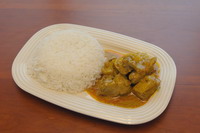
Food Safety Focus (21st Issue, April 2008) – Incident in Focus
The Troublemaker in Gravies :
Clostridium perfringens and Food Poisoning
Reported by Dr. Ken CHONG, Scientific Officer,
Risk Assessment Section, Centre for Food Safety
Background
On 20 March 2008 , the Centre for Food Safety (CFS) released the latest food surveillance results. A sample of curry chicken with rice was detected with 100 000 per gram of Clostridium perfringens which was 10 times the relevant criterion stated in the Microbiological Guidelines for Ready-to-eat Food. The CFS has warned the food premise concerned for selling food product containing unacceptable level of pathogen which could pose risk to consumers' health. In this article, we shall focus on this particular pathogen.
Illustration: Curry chicken with rice 
Features of Clostridium perfringens
Clostridium perfringens is widely distributed in the environment and frequently found in intestines of both humans and animals, hence is likely to be present in foods of animal origin and vegetables exposed to soil, dust or faecal material. The organism is not uncommonly found in food, particularly gravies. Food containing less than 10 000 organisms per gram does not usually cause illness.
The organism is a spore-forming bacterium, which is able to form heat resistant spores under unfavourable condition, e.g. limited nutrient availability. Although the bacterium is an anaerobe, which grows in the absence of oxygen, it can tolerate low oxygen level for some time. The organism is characterised by their high optimum growth temperature, around 43°C–45°C, but unable to grow at temperature lower than 12°C. It can double its number as fast as every 7.1 minutes under optimum growth conditions, probably with the fastest growth rate among all foodborne bacteria.
Spore: A spore is a thick-walled structure formed under adverse conditions. It is resistant to heat, cold and chemical and is capable of becoming a vegetative cell (growing cell) under favourable conditions.
Occurrence of Infection
Food poisoning caused by Clostridium perfringens is usually associated with inadequately cooked foods and cooked foods that are cooled for prolonged period or stored under sub-optimal temperature. Heat of cooking can activate the germination of spores which survive in anaerobic conditions like inside internal cavities, rolls of meat, stuffed poultry, or gravies. The organism can then multiply in the area where oxygen level is low; cooling of food at ambient temperature for a long period allows rapid multiplication of the bacterium. Intake of the food containing large number of the organisms allows sufficient amount to survive the passage through stomach, which subsequently form spores accompanied with toxin in the intestine. Hence, foods prepared in bulk, especially cooked meat and poultry dishes, and stored at ambient temperatures with a long cooling period after cooking are at high risk.
Infective dose (number of organisms required to make individuals ill) of Clostridium perfringens has been suggested by U.S. Food and Drug Administration to be more than 100 million cells, which means taking around 1 kilogram of the sample of rice with curry chicken (100 000 cells per gram) could cause illness. However, infective dose also depends on the strains of organism and the individual's health and other conditions. Lower dosage may also cause illness.
Clostridium perfringens food poisoning:
- Symptoms: Intense abdominal pain and acute diarrhoea
- Usual onset time is 10–12 hours
- Recovery is usually within 24–48 hours
- Less severe symptoms may persist in some individuals
- Fatal diseases are rare, but prolonged and severe symptoms are more likely to appear in debilitated or elderly persons.
In Hong Kong , from 2005 to 2007, there were 26, 49 and 17 food poisoning outbreaks reported to the Centre for Health Protection which were associated with Clostridium perfringens, affecting 280, 263 and 72 persons respectively. Such food poisoning outbreaks were associated with beef, pork and chicken. On the other hand, unsatisfactory levels of Clostridium perfringens were mainly found in mixed dishes, rice and noodle dishes, congee and dim sum as revealed in past food surveillance data.
Advice to Trade
- Cook food thoroughly and serve cooked food as soon as possible, or keep the food at 60°C or above if it is not consumed immediately.
- Pre-cooked food subjected to cold storage should be cooled from 60°C to 20°C within 2 hours; and from 20°C to 4°C inside a chiller within the next 4 hours.
- Reduce the cooling time of cooked food, for example, by dividing into small portions, placing in shallow containers and/or placing in ice bath.
- Reheat cooked food thoroughly till the core temperature reaches at least 75°C or bring it to a boil.
Advice to Consumers
- Avoid storage of food at ambient temperature for more than two hours.
- Discard leftovers or otherwise store them properly in the refrigerator at 4°C or below.
- Reheat leftovers thoroughly, till the core temperature reaches at least 75°C or bring them to a boil before consumption.
Key Points to Note:
- Clostridium perfringens is spore-forming and grows without oxygen.
- Gravies held at room temperature for prolonged period provide favourable conditions for its growth.
- Pre-cooked or leftover foods should be stored and reheated properly before consumption.

